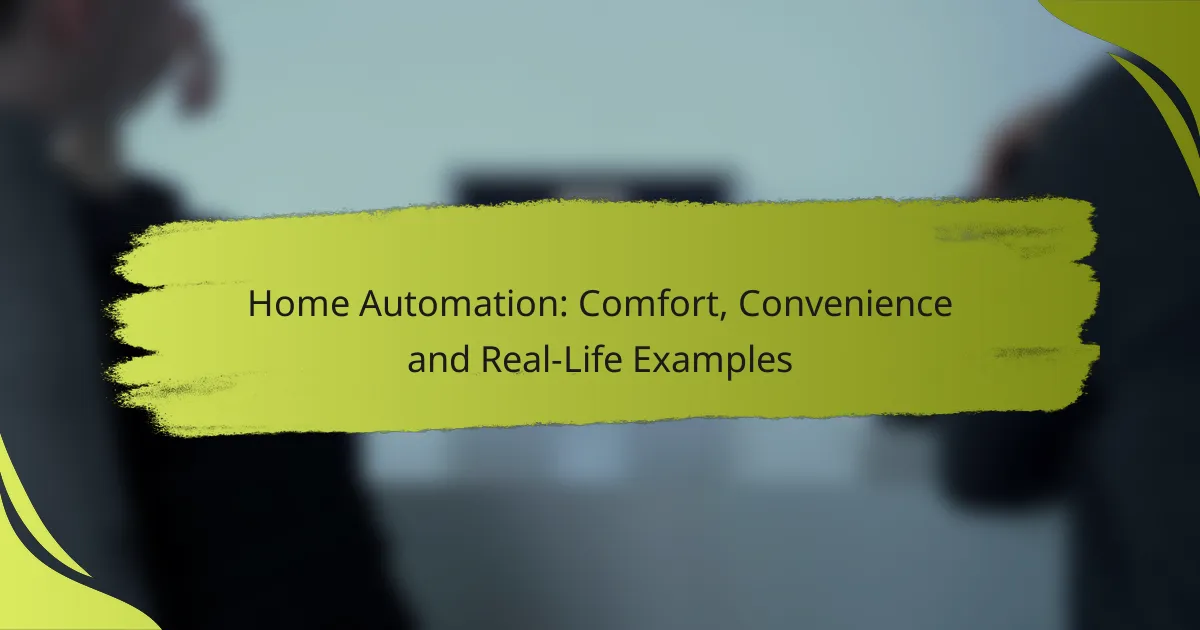Home automation transforms everyday living by enhancing comfort, convenience, and energy efficiency. By integrating smart devices, homeowners can effortlessly manage their environments, tailoring settings to their preferences and streamlining daily tasks. In India, popular systems like Google Nest, Philips Hue, and Samsung SmartThings exemplify how technology can create a more efficient and enjoyable home experience.
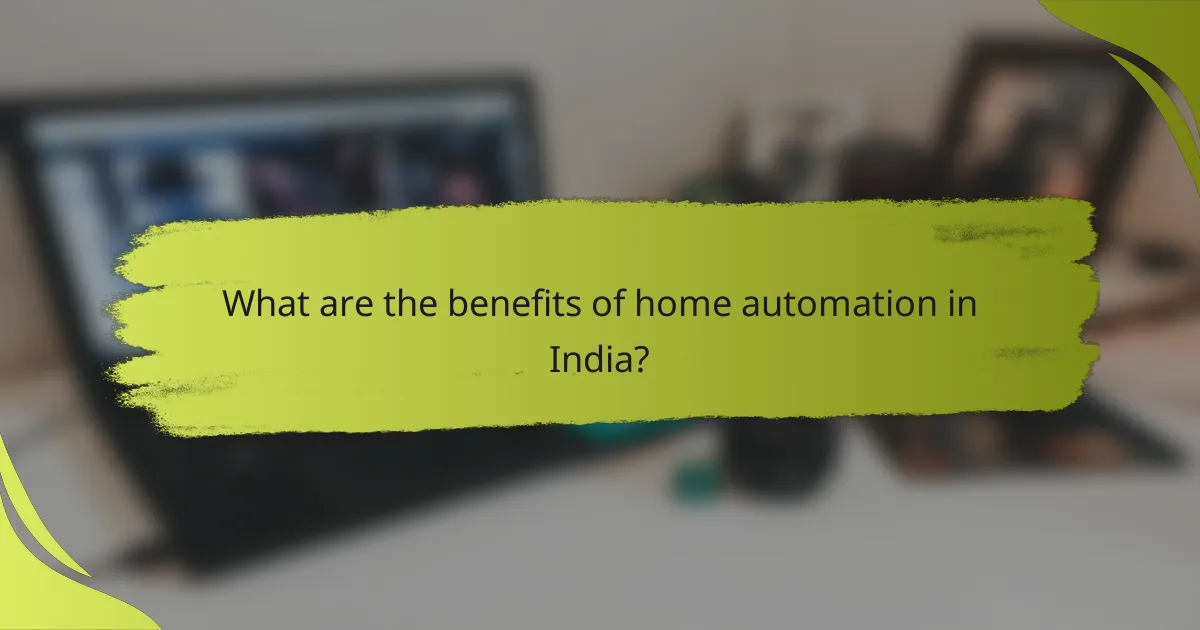
What are the benefits of home automation in India?
Home automation in India offers numerous benefits, including enhanced comfort, improved energy efficiency, and increased security. These systems allow homeowners to control various aspects of their living environment, leading to a more convenient and efficient lifestyle.
Enhanced comfort through smart devices
Smart devices significantly enhance comfort by allowing users to customize their home environment. For instance, smart thermostats can adjust temperatures based on personal preferences, ensuring optimal comfort throughout the day. Automated lighting systems can create the perfect ambiance by adjusting brightness and color temperature according to the time of day.
Additionally, smart speakers and home assistants can facilitate hands-free control of various devices, making it easier to manage daily tasks. This level of control can lead to a more pleasant and relaxing home atmosphere.
Increased energy efficiency with automated systems
Home automation systems contribute to energy efficiency by optimizing the use of electricity and reducing waste. Smart thermostats can learn user habits and adjust heating or cooling accordingly, potentially saving homeowners a significant percentage on energy bills. For example, setting schedules for heating or cooling can ensure that energy is not wasted when the home is unoccupied.
Moreover, smart lighting systems can turn off automatically when rooms are empty, further conserving energy. Homeowners can track their energy consumption through mobile apps, allowing for better management of energy use and costs.
Improved security with smart surveillance
Smart surveillance systems enhance home security by providing real-time monitoring and alerts. Homeowners can install smart cameras that allow them to view live feeds from their smartphones, ensuring peace of mind whether they are at home or away. Many systems also offer motion detection and automatic alerts, which can help deter potential intruders.
Additionally, smart locks can be controlled remotely, allowing homeowners to grant access to visitors without being physically present. This level of control and monitoring contributes to a safer living environment.
Convenience of remote control via mobile apps
Remote control through mobile apps is a key convenience of home automation. Homeowners can manage their smart devices from anywhere, whether at work or on vacation. This capability allows for quick adjustments, such as turning off lights or adjusting the thermostat, ensuring that homes are always comfortable and secure.
Many apps also offer integration with voice assistants, enabling users to control devices through simple voice commands. This hands-free approach adds an extra layer of convenience, making daily routines smoother and more efficient.
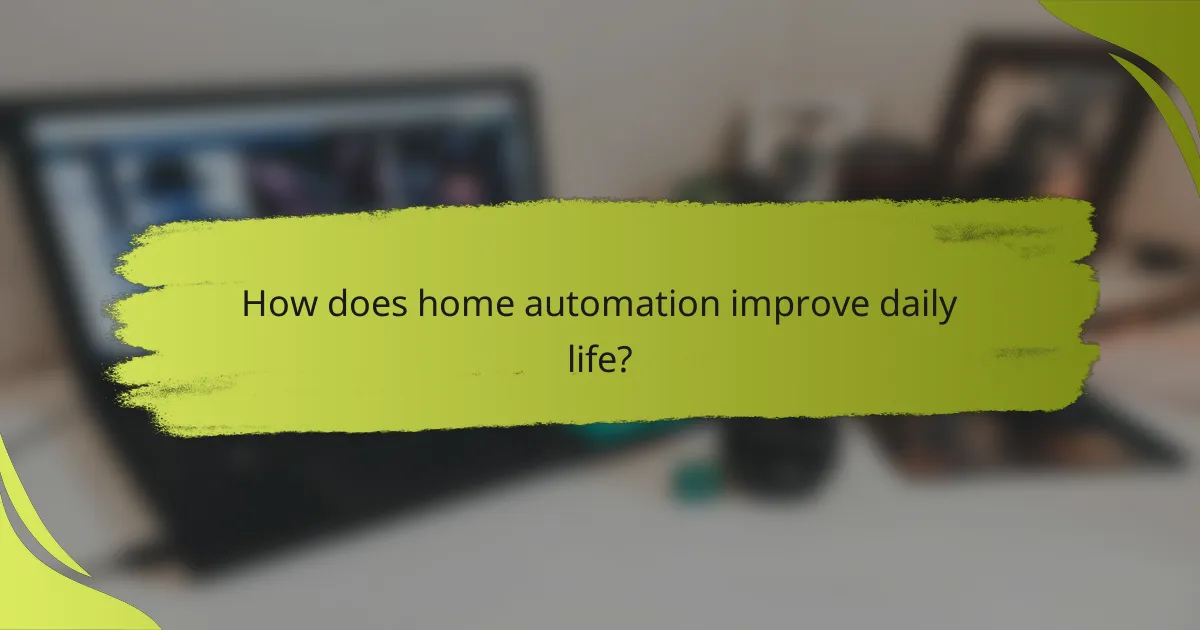
How does home automation improve daily life?
Home automation enhances daily life by increasing comfort, convenience, and efficiency in managing household tasks. By integrating smart devices, users can streamline their routines and create personalized environments that cater to their preferences.
Streamlined routines with scheduling features
Scheduling features in home automation systems allow users to automate everyday tasks, such as adjusting the thermostat or turning lights on and off at specific times. This capability can save time and energy, making daily routines more efficient.
For example, you can set your coffee maker to start brewing at 7 AM, ensuring a fresh cup is ready when you wake up. Similarly, outdoor lights can be programmed to turn on at sunset, enhancing security and convenience.
Integration of voice assistants like Amazon Alexa
Voice assistants, such as Amazon Alexa, enable hands-free control of smart devices, making home automation even more user-friendly. With simple voice commands, you can adjust settings, play music, or check the weather without needing to interact with multiple apps or devices.
For instance, saying “Alexa, dim the living room lights” instantly creates the desired ambiance for movie night. This integration not only enhances convenience but also allows for quick adjustments during busy moments.
Personalized environments with smart lighting
Smart lighting systems offer the ability to customize brightness and color to suit different activities or moods. This personalization can significantly enhance comfort in your home, whether you’re working, relaxing, or entertaining guests.
Consider using warm tones for a cozy atmosphere during dinner or bright, cool tones for focused work sessions. Many smart lighting systems can be controlled remotely, allowing you to adjust settings even when you’re away from home.
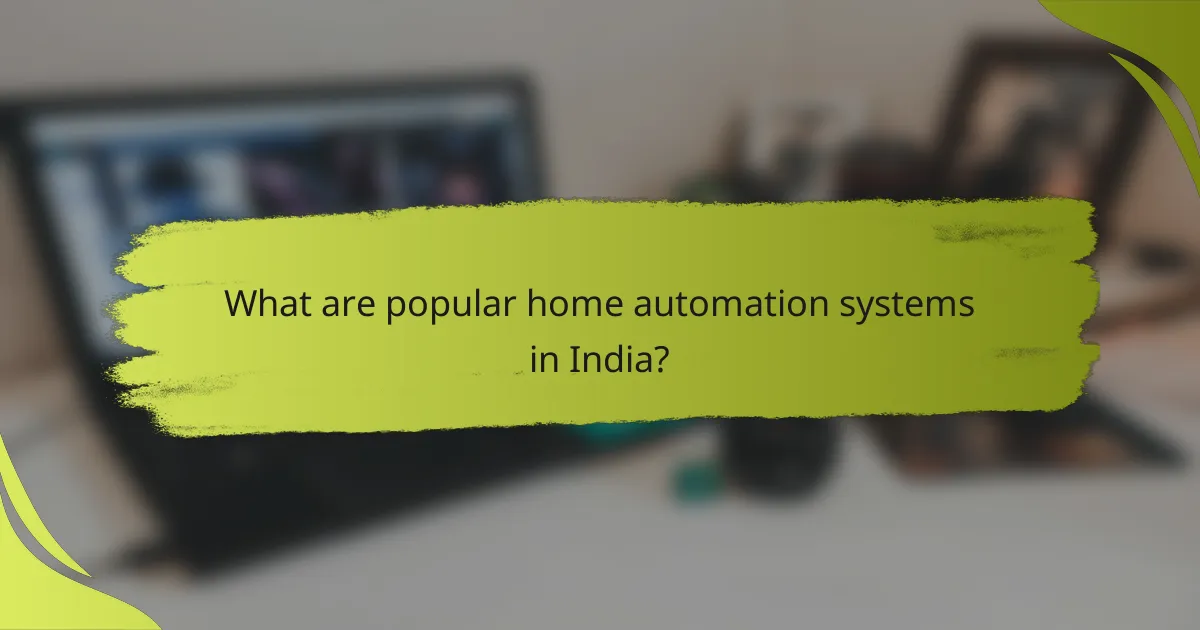
What are popular home automation systems in India?
In India, popular home automation systems include Google Nest, Philips Hue, and Samsung SmartThings. These systems enhance comfort and convenience by allowing users to control various home devices through centralized platforms.
Google Nest for smart home management
Google Nest offers a comprehensive solution for smart home management, integrating various devices like thermostats, cameras, and speakers. Users can control their home environment through voice commands or the Google Home app, making it easy to adjust settings remotely.
Consider compatibility when choosing Google Nest, as it works best with devices that support Google Assistant. This system is ideal for those who prioritize voice control and seamless integration with other Google services.
Philips Hue for smart lighting solutions
Philips Hue provides a versatile smart lighting solution that allows users to customize their home lighting experience. With options for color changes, dimming, and scheduling, Philips Hue lights can create the perfect ambiance for any occasion.
Installation is straightforward, requiring a Hue Bridge to connect the lights to your Wi-Fi network. Users should ensure their existing light fixtures are compatible and consider the initial investment, which can vary based on the number of bulbs and features desired.
Samsung SmartThings for device integration
Samsung SmartThings is a powerful platform for integrating various smart devices, enabling users to control everything from security cameras to smart appliances. The SmartThings app acts as a central hub, allowing for automation routines and remote access.
When using SmartThings, ensure that your devices are compatible with the platform, as it supports a wide range of brands. This system is particularly beneficial for users looking to create a cohesive smart home ecosystem with diverse devices working together efficiently.

What factors to consider when choosing home automation?
When selecting a home automation system, consider compatibility with existing devices, scalability for future upgrades, and ease of use for all family members. These factors ensure that your system meets current needs while allowing for growth and accessibility.
Compatibility with existing devices
Ensure that the home automation system you choose can integrate seamlessly with your current devices, such as smart thermostats, lights, and security systems. Check for compatibility with popular protocols like Zigbee, Z-Wave, or Wi-Fi to avoid future headaches.
For example, if you already have smart bulbs from a specific brand, confirm that the new automation hub supports them. This can save you from having to replace functional devices, keeping costs down.
Scalability for future upgrades
Opt for a home automation system that allows for easy expansion as your needs evolve. Look for platforms that support a wide range of devices and features, enabling you to add new components without significant reconfiguration.
Consider systems that offer modular upgrades, such as additional sensors or smart appliances. This flexibility can help you adapt to changing technology trends and personal preferences over time.
Ease of use for all family members
The home automation system should be user-friendly for everyone in the household, regardless of their tech-savviness. Look for interfaces that are intuitive and offer mobile app control, voice commands, or physical remotes.
Training family members on how to use the system can also enhance comfort and convenience. Consider systems that provide clear instructions and customer support to assist users of all ages.
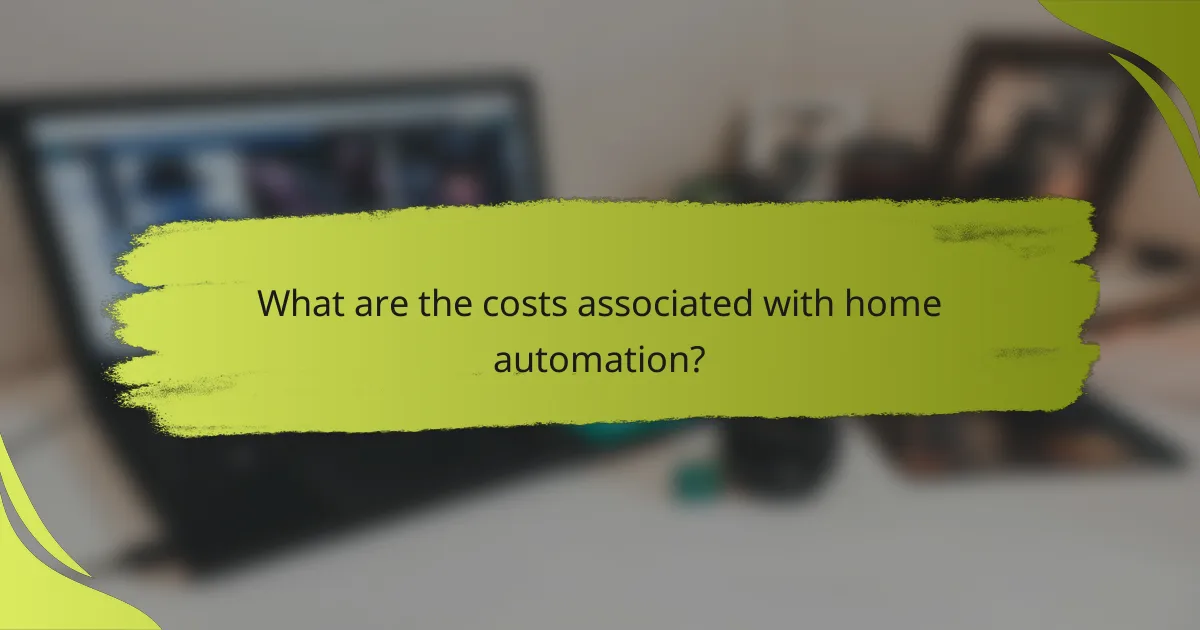
What are the costs associated with home automation?
The costs associated with home automation can vary widely based on the devices chosen and the complexity of the system. Initial setup costs, ongoing subscription fees, and potential savings on energy bills are key factors to consider when evaluating the overall investment in smart home technology.
Initial setup costs for smart devices
Initial setup costs for smart devices can range from a few hundred to several thousand dollars, depending on the number and type of devices installed. Basic systems may include smart lights, thermostats, and security cameras, while more comprehensive setups could involve smart locks, home assistants, and integrated systems.
When budgeting for home automation, consider both the cost of the devices and any necessary installation fees. Some homeowners may opt for DIY installation to save money, while others may prefer professional installation for more complex systems.
Ongoing subscription fees for services
Many smart home devices require ongoing subscription fees for cloud services, advanced features, or additional functionality. These fees can range from a few dollars per month to over a hundred dollars annually, depending on the service and the number of devices connected.
It’s important to evaluate the subscription costs associated with each device or service before making a purchase. Some devices may offer free basic services, while premium features could incur additional charges, impacting the overall cost of home automation.
Potential savings on energy bills
Investing in home automation can lead to potential savings on energy bills by optimizing energy usage. Smart thermostats, for example, can learn your schedule and adjust heating and cooling accordingly, potentially reducing energy consumption by 10-15%.
Additionally, smart lighting systems can automatically turn off lights when not in use, further contributing to energy savings. While the initial investment may be significant, the long-term savings on utility bills can help offset these costs over time.

How to install a home automation system?
Installing a home automation system involves assessing your needs, selecting appropriate devices, and setting them up for seamless integration. This process enhances comfort and convenience in your living space.
Step 1: Assess your home’s needs
Begin by evaluating which areas of your home would benefit most from automation. Consider factors like security, energy efficiency, and convenience. For instance, you might want to automate lighting in high-traffic areas or enhance security with smart locks and cameras.
Make a list of specific tasks you want to automate, such as controlling the thermostat remotely or scheduling lights to turn on at sunset. This will help you prioritize your purchases and ensure the system meets your lifestyle requirements.
Step 2: Choose the right devices
Select devices that align with your assessed needs and are compatible with each other. Popular options include smart thermostats, lighting systems, security cameras, and voice assistants. Ensure that the devices you choose can communicate over common protocols like Wi-Fi, Zigbee, or Z-Wave.
Consider the long-term costs associated with each device, including installation, maintenance, and potential subscription fees. For example, some security systems may require a monthly monitoring fee, while others operate without ongoing costs. Compare features and reviews to find the best fit for your home automation goals.
